2017 Hyundai Elantra chapter 5
[x] Cancel search: chapter 5Page 6 of 571

F6
Introduction
We want to help you get the greatest
possible driving pleasure from your
vehicle. Your Owner’s Manual can
assist you in many ways. We strongly
recommend that you read the entire
manual. In order to minimise the
chance of death or injury, you must
read the WARNING and CAUTION
sections in the manual.
Illustrations complement the words
in this manual to best explain how to
enjoy your vehicle. By reading your
manual, you will learn about fea-
tures, important safety information,
and driving tips under various road
conditions.
The general layout of the manual is
provided in the Table of Contents.
Use the index when looking for a
specific area or subject; it has an
alphabetical listing of all information
in your manual.
Sections: This manual has eight
chapters plus an index. Each section
begins with a brief list of contents so
you can tell at a glance if that section
has the information you want.
Yo u r s a f e t y, a n d t h e s a f e t y o f o t h e r s ,
is very important. This Owner's
Manual provides you with many safe-
ty precautions and operating proce-
dures. This information alerts you to
potential hazards that may hurt you
or others, as well as damage to your
vehicle.
Safety messages found on vehicle
labels and in this manual describe
these hazards and what to do to
avoid or reduce the risks.
War nings and instr uctions contained
in this manual are for your safety.
Failure to follow safety war nings and
instructions can lead to serious injury
or death.
Throughout this manual DANGER,
WARNING, CAUTION, NOTICE and
the SAFETY ALERT SYMBOL will
be used.
This is the safety alert sym-
bol. It is used to alert you to
potential physical injury haz-
ards. Obey all safety mes-
sages that follow this symbol
to avoid possible injury or
death. The safety alert sym-
bol precedes the signal words
DANGER, WARNING and
CAUTION.
HHOOWW TTOO UUSSEE TTHHIISS MMAANNUUAALL
DANGER indicates a hazardous
situation which, if not avoided,
will result in death or serious
injury.
DANGER
WA R N I N G i n d i c a t e s a h a z a rd o u s
situation which, if not avoided,
could result in death or serious
injury.
WA R N I N G
Page 28 of 571
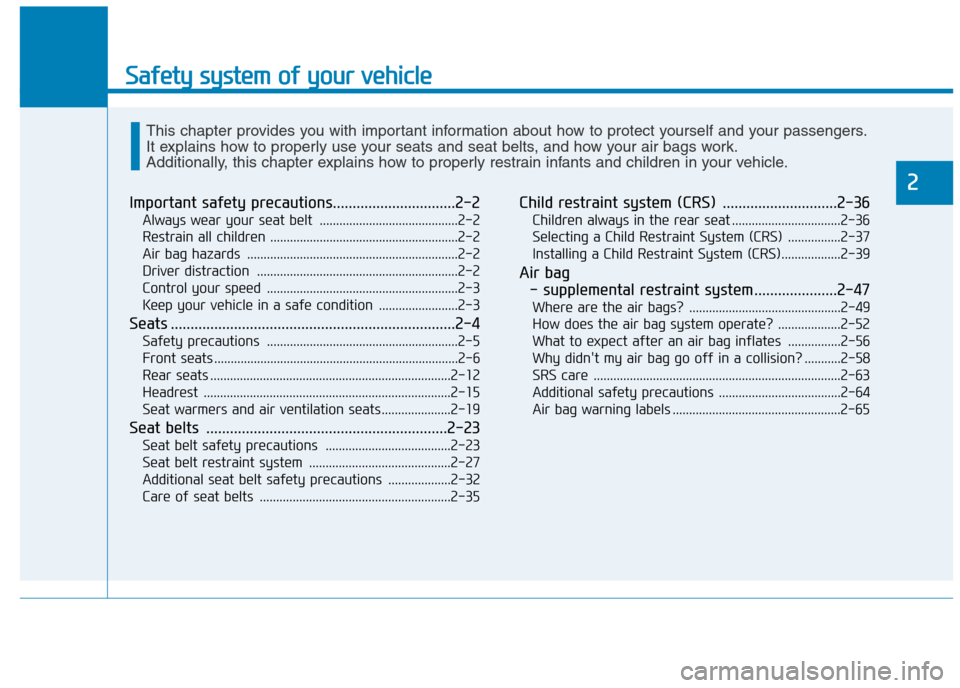
Safety system of your vehicle
2
Important safety precautions...............................2-2
Always wear your seat belt ..........................................2-2
Restrain all children .........................................................2-2
Air bag hazards ................................................................2-2
Driver distraction .............................................................2-2
Control your speed ..........................................................2-3
Keep your vehicle in a safe condition ........................2-3
Seats ........................................................................2-4
Safety precautions ..........................................................2-5
Front seats ..........................................................................2-6
Rear seats .........................................................................2-12
Headrest ...........................................................................2-15
Seat warmers and air ventilation seats.....................2-19
Seat belts .............................................................2-23
Seat belt safety precautions ......................................2-23
Seat belt restraint system ...........................................2-27
Additional seat belt safety precautions ...................2-32
Care of seat belts ..........................................................2-35
Child restraint system (CRS) .............................2-36
Children always in the rear seat .................................2-36
Selecting a Child Restraint System (CRS) ................2-37
Installing a Child Restraint System (CRS)..................2-39
Air bag
- supplemental restraint system.....................2-47
Where are the air bags? ..............................................2-49
How does the air bag system operate? ...................2-52
What to expect after an air bag inflates ................2-56
Why didn't my air bag go off in a collision? ...........2-58
SRS care ...........................................................................2-63
Additional safety precautions .....................................2-64
Air bag warning labels ...................................................2-65
This chapter provides you with important information about how to protect yourself and your passengers.
It explains how to properly use your seats and seat belts, and how your air bags work.
Additionally, this chapter explains how to properly restrain infants and children in your vehicle.
Page 59 of 571
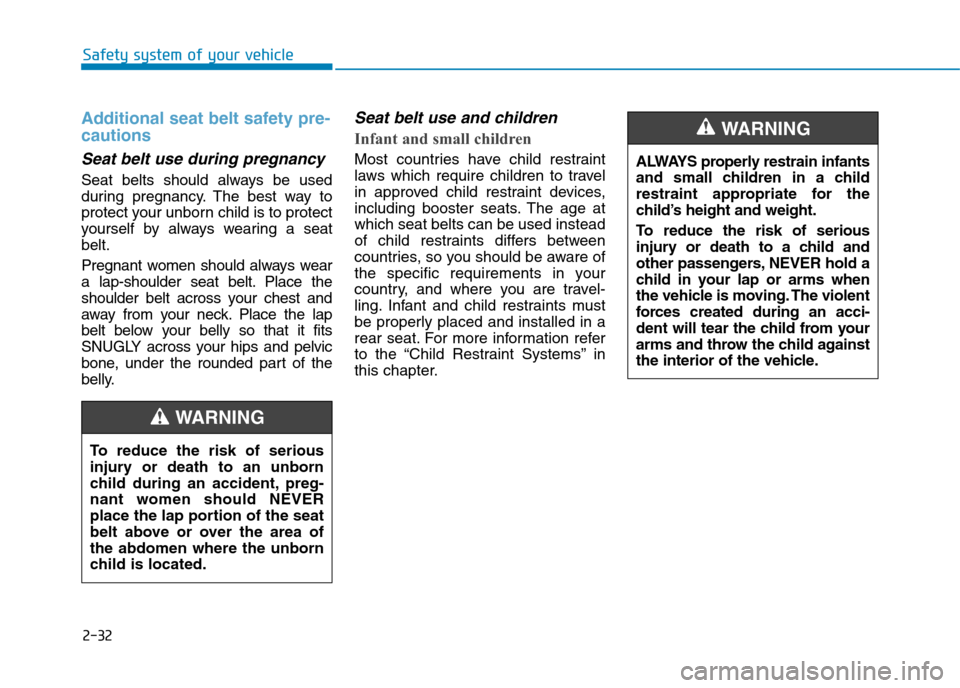
2-32
Safety system of your vehicle
Additional seat belt safety pre-
cautions
Seat belt use during pregnancy
Seat belts should always be used
during pregnancy. The best way to
protect your unborn child is to protect
yourself by always wearing a seat
belt.
Pregnant women should always wear
a lap-shoulder seat belt. Place the
shoulder belt across your chest and
away from your neck. Place the lap
belt below your belly so that it fits
SNUGLY across your hips and pelvic
bone, under the rounded part of the
belly.
Seat belt use and children
Infant and small children
Most countries have child restraint
laws which require children to travel
in approved child restraint devices,
including booster seats. The age at
which seat belts can be used instead
of child restraints differs between
countries, so you should be aware of
the specific requirements in your
country, and where you are travel-
ling. Infant and child restraints must
be properly placed and installed in a
rear seat. For more information refer
to the “Child Restraint Systems” in
this chapter.
To r e d u c e t h e r i s k o f s e r i o u s
injury or death to an unborn
child during an accident, preg-
nant women should NEVER
place the lap portion of the seat
belt above or over the area of
the abdomen where the unborn
child is located.
WA R N I N G
ALWAYS properly restrain infants
and small children in a child
restraint appropriate for the
child’s height and weight.
To r e d u c e t h e r i s k o f s e r i o u s
injury or death to a child and
other passengers, NEVER hold a
child in your lap or arms when
the vehicle is moving. The violent
forces created during an acci-
dent will tear the child from your
arms and throw the child against
the interior of the vehicle.
WA R N I N G
Page 60 of 571
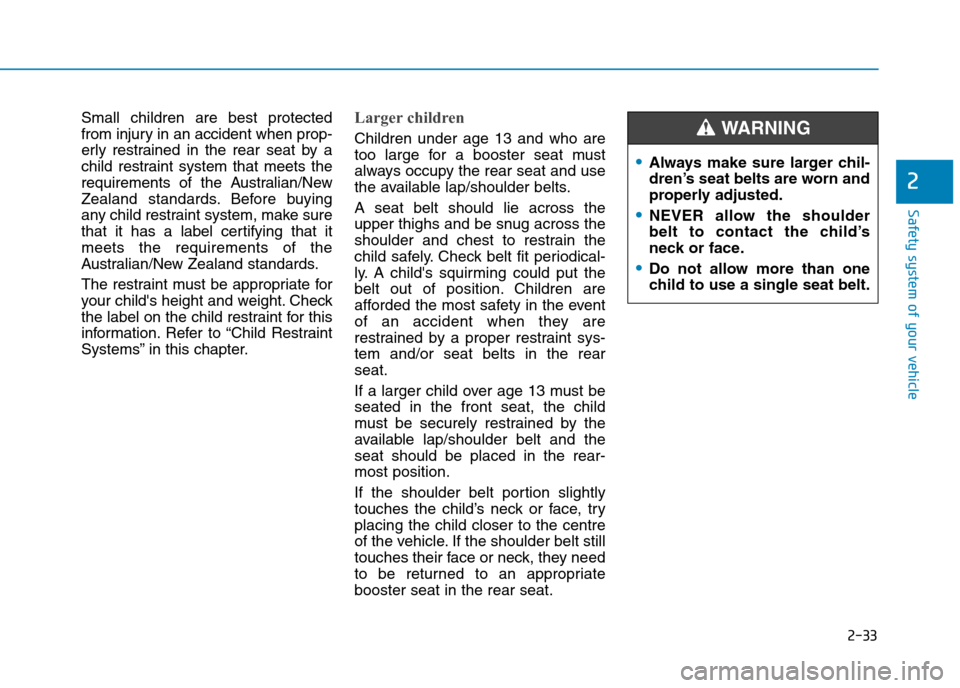
2-33
Safety system of your vehicle
2
Small children are best protected
from injury in an accident when prop-
erly restrained in the rear seat by a
child restraint system that meets the
requirements of the Australian/New
Zealand standards. Before buying
any child restraint system, make sure
that it has a label certifying that it
meets the requirements of the
Australian/New Zealand standards.
The restraint must be appropriate for
your child's height and weight. Check
the label on the child restraint for this
information. Refer to “Child Restraint
Systems” in this chapter.
Larger children
Children under age 13 and who are
too large for a booster seat must
always occupy the rear seat and use
the available lap/shoulder belts.
A seat belt should lie across the
upper thighs and be snug across the
shoulder and chest to restrain the
child safely. Check belt fit periodical-
ly. A child's squirming could put the
belt out of position. Children are
afforded the most safety in the event
of an accident when they are
restrained by a proper restraint sys-
tem and/or seat belts in the rear
seat.
If a larger child over age 13 must be
seated in the front seat, the child
must be securely restrained by the
available lap/shoulder belt and the
seat should be placed in the rear-
most position.
If the shoulder belt portion slightly
touches the child’s neck or face, try
placing the child closer to the centre
of the vehicle. If the shoulder belt still
touches their face or neck, they need
to be returned to an appropriate
booster seat in the rear seat.
•Always make sure larger chil-
dren’s seat belts are worn and
properly adjusted.
•NEVER allow the shoulder
belt to contact the child’s
neck or face.
•Do not allow more than one
child to use a single seat belt.
WA R N I N G
Page 72 of 571
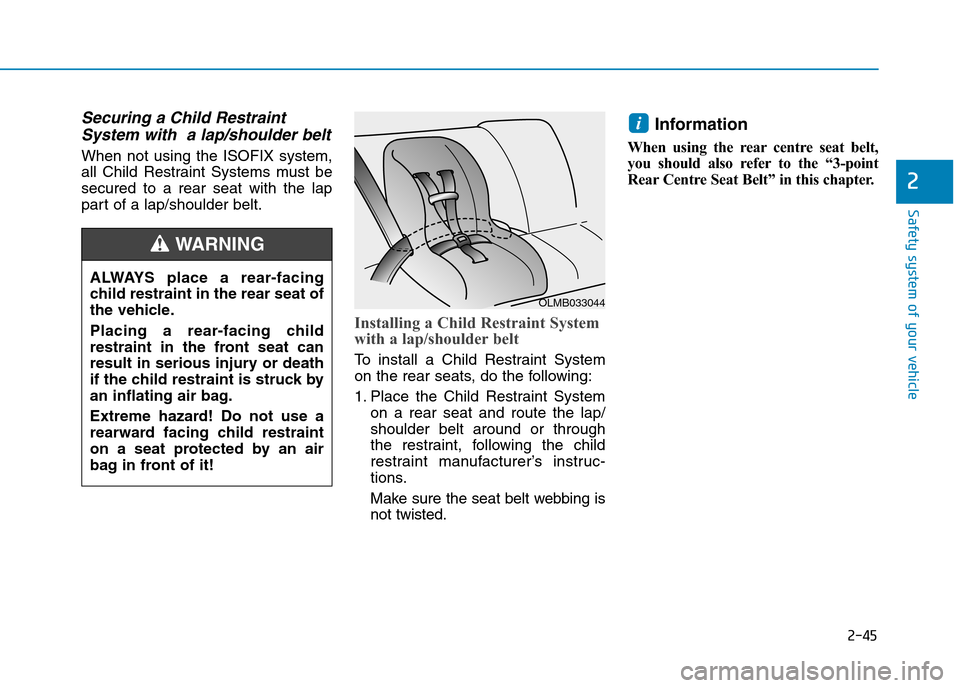
2-45
Safety system of your vehicle
2
Securing a Child Restraint
System with a lap/shoulder belt
When not using the ISOFIX system,
all Child Restraint Systems must be
secured to a rear seat with the lap
part of a lap/shoulder belt.
Installing a Child Restraint System
with a lap/shoulder belt
To i n s t a l l a C h i l d R e s t r a i n t S y s t e m
on the rear seats, do the following:
1. Place the Child Restraint System
on a rear seat and route the lap/
shoulder belt around or through
the restraint, following the child
restraint manufacturer’s instruc-
tions.
Make sure the seat belt webbing is
not twisted.
Information
When using the rear centre seat belt,
you should also refer to the “3-point
Rear Centre Seat Belt” in this chapter.
i
ALWAYS place a rear-facing
child restraint in the rear seat of
the vehicle.
Placing a rear-facing child
restraint in the front seat can
result in serious injury or death
if the child restraint is struck by
an inflating air bag.
Extreme hazard! Do not use a
rearward facing child restraint
on a seat protected by an air
bag in front of it!
WA R N I N G
OLMB033044
Page 97 of 571
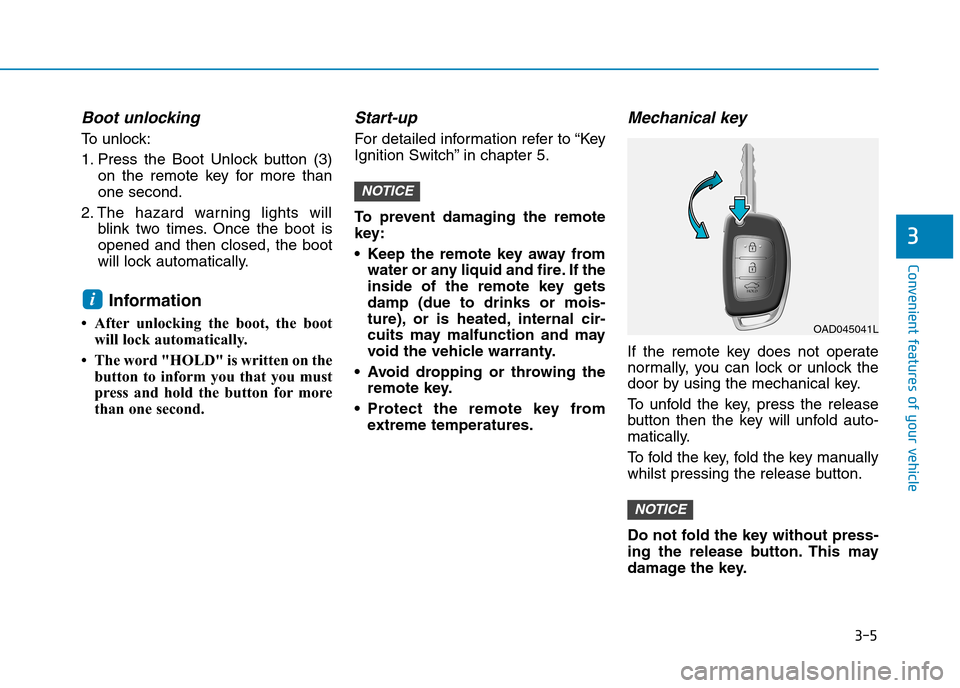
3-5
Convenient features of your vehicle
Boot unlocking
To u n l o c k :
1. Press the Boot Unlock button (3)
on the remote key for more than
one second.
2. The hazard warning lights will
blink two times. Once the boot is
opened and then closed, the boot
will lock automatically.
Information
• After unlocking the boot, the boot
will lock automatically.
• The word "HOLD" is written on the
button to inform you that you must
press and hold the button for more
than one second.
Start-up
For detailed infor mation refer to “Key
Ignition Switch” in chapter 5.
To p r e v e n t d a m a g i n g t h e r e m o t e
key:
•Keep the remote key away from
water or any liquid and fire. If the
inside of the remote key gets
damp (due to drinks or mois-
ture), or is heated, internal cir-
cuits may malfunction and may
void the vehicle warranty.
•Avoid dropping or throwing the
remote key.
•Protect the remote key from
extreme temperatures.
Mechanical key
If the remote key does not operate
normally, you can lock or unlock the
door by using the mechanical key.
To u n f o l d t h e k e y, p r e s s t h e r e l e a s e
button then the key will unfold auto-
matically.
To f o l d t h e k e y, f o l d t h e k e y m a n u a l l y
whilst pressing the release button.
Do not fold the key without press-
ing the release button. This may
damage the key.
NOTICE
NOTICE
i
3
OAD045041L
Page 102 of 571
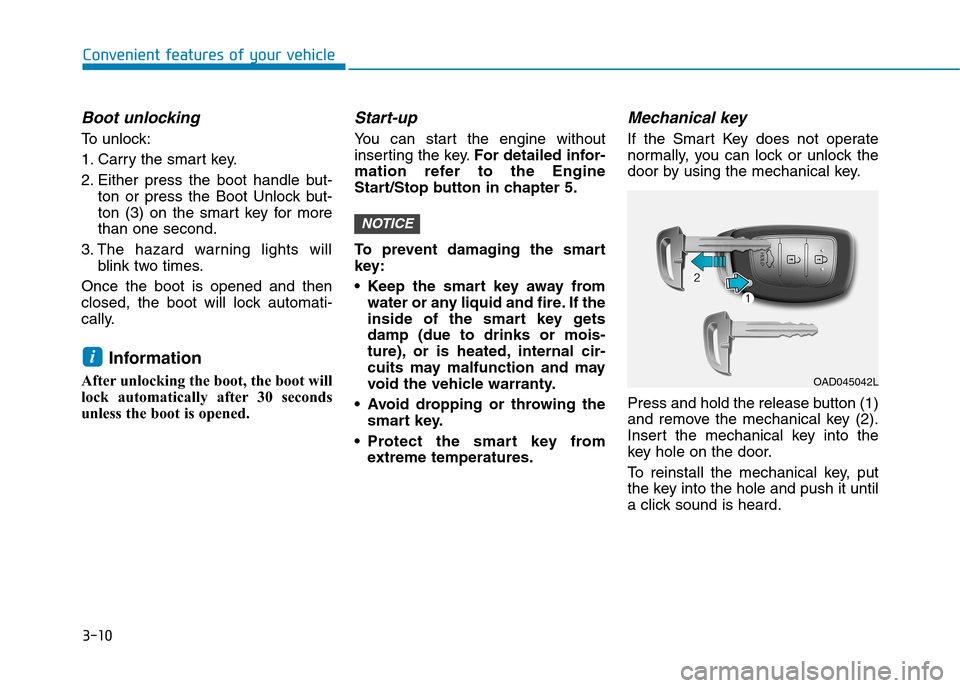
3-10
Convenient features of your vehicle
Boot unlocking
To u n l o c k :
1. Carry the smart key.
2. Either press the boot handle but-
ton or press the Boot Unlock but-
ton (3) on the smart key for more
than one second.
3. The hazard warning lights will
blink two times.
Once the boot is opened and then
closed, the boot will lock automati-
cally.
Information
After unlocking the boot, the boot will
lock automatically after 30 seconds
unless the boot is opened.
Start-up
Yo u c a n s t a r t t h e e n g i n e w i t h o u t
inserting the key.For detailed infor-
mation refer to the Engine
Start/Stop button in chapter 5.
To p r e v e n t d a m a g i n g t h e s m a r t
key:
•Keep the smart key away from
water or any liquid and fire. If the
inside of the smart key gets
damp (due to drinks or mois-
ture), or is heated, internal cir-
cuits may malfunction and may
void the vehicle warranty.
•Avoid dropping or throwing the
smart key.
•Protect the smart key from
extreme temperatures.
Mechanical key
If the Smart Key does not operate
normally, you can lock or unlock the
door by using the mechanical key.
Press and hold the release button (1)
and remove the mechanical key (2).
Insert the mechanical key into the
key hole on the door.
To r e i n s t a l l t h e m e c h a n i c a l k e y, p u t
the key into the hole and push it until
a click sound is heard.
NOTICE
i
OAD045042L
Page 110 of 571
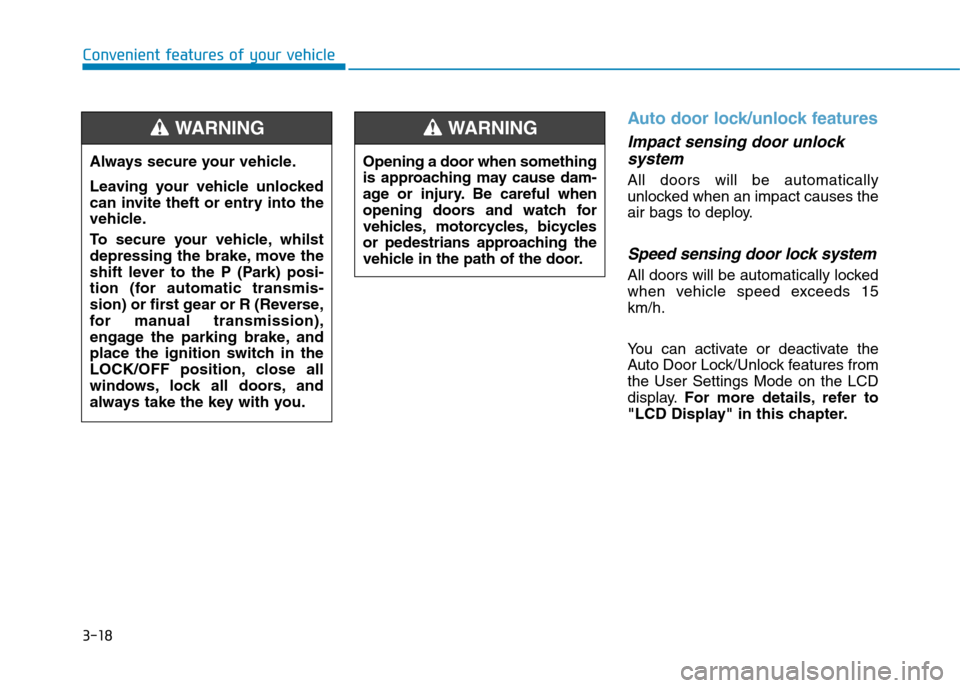
3-18
Convenient features of your vehicle
Auto door lock/unlock features
Impact sensing door unlock
system
All doors will be automatically
unlocked when an impact causes the
air bags to deploy.
Speed sensing door lock system
All doors will be automatically locked
when vehicle speed exceeds 15
km/h.
Yo u c a n a c t i v a t e o r d e a c t i v a t e t h e
Auto Door Lock/Unlock features from
the User Settings Mode on the LCD
display.For more details, refer to
"LCD Display" in this chapter.
Always secure your vehicle.
Leaving your vehicle unlocked
can invite theft or entry into the
vehicle.
To s e c u r e y o u r v e h i c l e , w h i l s t
depressing the brake, move the
shift lever to the P (Park) posi-
tion (for automatic transmis-
sion) or first gear or R (Reverse,
for manual transmission),
engage the parking brake, and
place the ignition switch in the
LOCK/OFF position, close all
windows, lock all doors, and
always take the key with you.
WA R N I N G
Opening a door when something
is approaching may cause dam-
age or injury. Be careful when
opening doors and watch for
vehicles, motorcycles, bicycles
or pedestrians approaching the
vehicle in the path of the door.
WA R N I N G